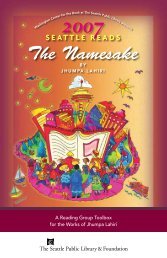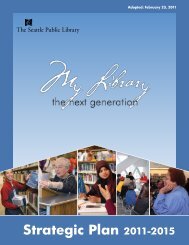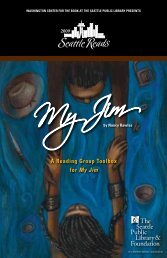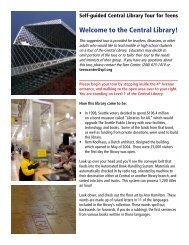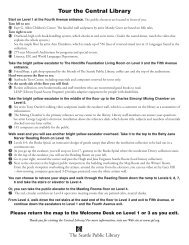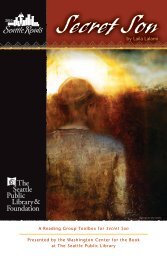Introduction to Isabel Allende: A Brief Biography
Introduction to Isabel Allende: A Brief Biography
Introduction to Isabel Allende: A Brief Biography
Create successful ePaper yourself
Turn your PDF publications into a flip-book with our unique Google optimized e-Paper software.
<strong>Introduction</strong> <strong>to</strong> <strong>Isabel</strong> <strong>Allende</strong>: A <strong>Brief</strong> <strong>Biography</strong><br />
<strong>Isabel</strong> <strong>Allende</strong> was born in 1942 in Lima, Peru. She moved <strong>to</strong> the<br />
Chile fictionalized in her novels when her parents divorced three years<br />
later. The small family – Doña Panchita, <strong>Isabel</strong>, and her two brothers –<br />
moved in with <strong>Isabel</strong>’s maternal grandfather in Santiago. Although her<br />
father severed contact with his wife and children, <strong>Allende</strong> remained<br />
close <strong>to</strong> her father’s family, including her second cousin and godfather,<br />
Salvador <strong>Allende</strong> Gossens, whom she called “uncle.” It was in Santiago<br />
that <strong>Allende</strong> began <strong>to</strong> soak up the s<strong>to</strong>ries of her ances<strong>to</strong>rs, s<strong>to</strong>ries that<br />
would serve <strong>to</strong> form the basis of her first novel, The House of the Spirits.<br />
In the introduction <strong>to</strong> My Invented Country, <strong>Allende</strong> writes: “I have<br />
been an outsider nearly all my life… . I have been a pilgrim along more<br />
roads than I care <strong>to</strong> remember” (p. xi). This sense of foreignness was<br />
exacerbated when her father, a diplomat with the Chilean government,<br />
was appointed first <strong>to</strong> Bolivia, then Beirut. In both places, <strong>Allende</strong><br />
attended private English-speaking schools, an experience that made her<br />
even more aware of her status as an outsider.<br />
The Suez Canal crisis in 1958 led <strong>to</strong> <strong>Allende</strong>’s return <strong>to</strong> Santiago,<br />
where she finished her studies and met Miguel Frías, her first husband.<br />
Married in 1962, <strong>Allende</strong> and Frías had their first child, daughter Paula,<br />
then lived in Europe for two years, returning <strong>to</strong> Chile where their son,<br />
Nicolás, was born in 1966. During this period, <strong>Allende</strong> also worked for<br />
the United Nations in Santiago, becoming a press officer in the<br />
department of information. This work and her time in Europe<br />
awakened <strong>Allende</strong> <strong>to</strong> the disadvantages of being a woman in a<br />
patriarchal Chilean society.<br />
<strong>Allende</strong>’s journalistic career became more political in 1967, when<br />
she began writing for the feminist women’s magazine, Paula. She<br />
continued writing a humorous column and feature articles for the<br />
journal for the next seven years, while also contributing <strong>to</strong> a children’s<br />
magazine and anchoring two popular programs on Santiago television.<br />
According <strong>to</strong> <strong>Allende</strong>, “For the first time in my life, I belonged.” (My<br />
Invented Country, p. 132.)<br />
The September 11, 1973, coup led against <strong>Allende</strong>’s godfather,<br />
President Salvador <strong>Allende</strong>, marked the end of <strong>Allende</strong>’s “belonging.”<br />
As the Pinochet regime continued <strong>to</strong> tighten its grip on the politics and<br />
References <strong>to</strong> page numbers throughout this English <strong>to</strong>olbox<br />
refer <strong>to</strong> the English editions of the book.<br />
news of Chile, <strong>Allende</strong> increasingly found herself in a precarious<br />
situation. Finally, in 1975, she fled with her family <strong>to</strong> Venezuela, where<br />
they would live for 13 years. Once again, <strong>Allende</strong> was an outsider.<br />
Early in 1981, <strong>Allende</strong> received word that her 99-year-old<br />
grandfather was dying. On January 8, <strong>Allende</strong> started writing her first<br />
novel. The House of the Spirits began as a letter <strong>to</strong> her grandfather, a<br />
letter composed of the s<strong>to</strong>ries he had shared with her about their family<br />
when she was a child. “[The House of the Spirits] was … triggered … by<br />
nostalgia, by the desire <strong>to</strong> recover the world that I had lost after I had<br />
<strong>to</strong> leave my country and live in exile,” <strong>Allende</strong> explains. That sense of<br />
yearning and nostalgia has continued <strong>to</strong> imbue <strong>Allende</strong>’s novels. Her<br />
melding of his<strong>to</strong>ry and imagination makes her the leading female<br />
writer of magic realism, a Latin American literary style where fantasy<br />
and reality co-exist.<br />
The success of The House of the Spirits allowed <strong>Allende</strong> <strong>to</strong> leave her<br />
position at a secondary school in Caracas and begin writing novels full<br />
time. Her next novel, Of Love and Shadows, was fueled by the author’s<br />
anger at the terrible events in Chile: the love s<strong>to</strong>ry is set against the<br />
backdrop of the Pinochet dicta<strong>to</strong>rship’s atrocities. With Eva Luna and<br />
The S<strong>to</strong>ries of Eva Luna, <strong>Allende</strong>’s writing continued <strong>to</strong> be tied <strong>to</strong> her<br />
emotions – about herself, her Chile, and her new home, Venezuela.<br />
<strong>Allende</strong> was divorced in 1987. That same year she met the man<br />
who would spark the next stage of her pilgrim’s journey. <strong>Allende</strong><br />
married William Gordon, a Sausali<strong>to</strong> lawyer, and his s<strong>to</strong>ry became the<br />
core of her next novel, The Infinite Plan. Published originally in Spanish<br />
in 1991 (in English, in 1993), The Infinite Plan is <strong>Allende</strong>’s first book <strong>to</strong><br />
feature a world outside of her created Chile. The book alternates<br />
between third and first person <strong>to</strong> relate the s<strong>to</strong>ry of late 20th century<br />
America through the life of an itinerant cult leader’s son.<br />
Enjoying her new life in the United States, <strong>Allende</strong> once again<br />
began the slow process of starting <strong>to</strong> “belong,” only <strong>to</strong> have her life<br />
shattered in 1991 when her daughter, Paula, fell in<strong>to</strong> a year-long coma,<br />
and died. The resulting memoir, Paula (1995), begins with the<br />
memorable first line: “Listen, Paula. I’m going <strong>to</strong> tell you a s<strong>to</strong>ry, so<br />
that when you wake up you will not feel so lost.” Mostly comprised of<br />
her letters <strong>to</strong> her unconscious daughter, Paula is the closest that <strong>Allende</strong><br />
has come <strong>to</strong> writing an au<strong>to</strong>biography. In it, she shares the family<br />
s<strong>to</strong>ries that have inspired her novels.
<strong>Allende</strong> waited three years before publishing Aphrodite, a recipe<br />
and essay collection that focused on aphrodisiacs, in 1998. Daughter of<br />
Fortune, a novel about the Chilean experience in the California Gold<br />
Rush, followed. Daughter of Fortune features many of the trademarks of<br />
an <strong>Allende</strong> novel, illustrating the author’s love of both her new country<br />
and her Chilean past. This novel was followed by Portrait in Sepia,<br />
detailing the life of the granddaughter of the heroine of Daughter.<br />
During most of her exile <strong>Allende</strong> had always thought she would<br />
return <strong>to</strong> Chile. However, by the time Pinochet was removed from power,<br />
<strong>Allende</strong> had married her American husband, and her son and his family<br />
had followed her <strong>to</strong> a new life in California. Although still considering<br />
herself a Chilean, her roots had begun <strong>to</strong> be replanted in California.<br />
Then, on the 28th anniversary of the military coup in Chile, terrorists<br />
attacked the Pentagon and the World Trade Center. According <strong>to</strong> <strong>Allende</strong>,<br />
that was when “I gained a country.” (My Invented Country, p. xii.)<br />
Since that crisis, <strong>Allende</strong> published two more books, a young adult<br />
fantasy entitled City of the Beasts (2002), and My Invented Country: A<br />
Nostalgic Journey Through Chile (2003). Partially inspired by her love for<br />
her grandchildren, both titles focus on themes of family, self-discovery,<br />
and home.
My Invented Country<br />
1. What is the meaning of the title, “My Invented Country”?<br />
2. What initial impressions of Chile does one get from the opening<br />
scenes? How does landscape correspond <strong>to</strong> its inhabitants? In what<br />
ways does <strong>Allende</strong>’s persona reflect this geography?<br />
3. In the introduction, <strong>Allende</strong> writes, “Minotaurs lie in wait in the<br />
labyrinth of memory.” What might she mean? Does she confront a<br />
minotaur?<br />
4. What is the author trying <strong>to</strong> accomplish? Does she succeed? Why<br />
or why not?<br />
9. What does the book reveal about Chilean attitudes about sexism,<br />
racism, and political correctness? How might the book be different<br />
if the author had been male or mestizo? What is <strong>Allende</strong>’s attitude<br />
<strong>to</strong>wards her homeland?<br />
10. <strong>Allende</strong>’s fiction often features characters who have unusual<br />
perceptions of reality, or are able <strong>to</strong> tap in<strong>to</strong> spiritual worlds as<br />
easily as tangible ones. Does My Invented Country evoke any of these<br />
themes? In what way does it complete the memories recorded in<br />
her memoir, Paula?<br />
11. How, if at all, does this book fit in<strong>to</strong> the magic realism literary<br />
tradition, as seen in <strong>Allende</strong>’s novels such as The House of the Spirits?<br />
5. The book’s title reminds us of the subjectivity of memory. <strong>Allende</strong><br />
herself often says that she cannot tell the truth (i.e., only the facts)<br />
of her his<strong>to</strong>ry. What is the truth of My Invented Country?<br />
6. <strong>Allende</strong> spent many years of her life before exile abroad. How did<br />
this influence her as a fiction writer? How did it influence her as a<br />
Chilean woman?<br />
7. <strong>Allende</strong> powerfully recalls the aftermath of the September 11<br />
military coup that launched Pinochet’s reign of terror in 1973. She<br />
describes the fallout in personal terms: families <strong>to</strong>rn apart by<br />
informants, a nation’s faith in its elec<strong>to</strong>rate shaken, a vibrant<br />
cultural climate replaced by one of suppression. What are the<br />
parallels and differences between the trauma of Chile’s 9/11 events<br />
and those that occurred in the United States 28 years later?<br />
8. <strong>Allende</strong> writes that Chilean status was not heavily tied <strong>to</strong> wealth<br />
before the Pinochet years, but in contemporary Chile the ruling<br />
class is extremely affluent – possibly at the expense of a oncesizeable<br />
middle class. Is this situation uniquely Chilean, or were the<br />
1970s and 1980s were marked by similar economic shifts around<br />
the world?
City of the Beasts<br />
1. How does Alexander’s nightmare at the beginning of the s<strong>to</strong>ry,<br />
about the horrible black bird carrying his mother away, set the <strong>to</strong>ne<br />
for the entire book? What do birds represent in the s<strong>to</strong>ry? What<br />
hints does <strong>Allende</strong> give the reader about them prior <strong>to</strong> Alex’s<br />
understanding of his dreams and visions of birds?<br />
2. Alex’s father tells him that the Chinese character for “crisis” means<br />
both “danger” and “opportunity” (p. 14). How does the s<strong>to</strong>ry<br />
illustrate this concept?<br />
3. Professor Leblanc’s arrogant and pompous personality provides<br />
comic relief for both the reader and the characters in the s<strong>to</strong>ry.<br />
People don’t take him seriously until the end of the book when it is<br />
his quick thinking that saves the group from Captain Arios<strong>to</strong>. At<br />
the start of the expedition, he asserts that brutality is a natural state<br />
and that “compassion is a modern invention” of humans (p. 55).<br />
What does he learn that changes his opinion?<br />
4. How would you describe the Beasts? Is “beast” an appropriate term<br />
for them? Who are the real beasts in the s<strong>to</strong>ry? (See p. 108.)<br />
5. Does Kate love her grandson? Why does she force him <strong>to</strong> learn<br />
everything the hard way – by experience? What was she trying <strong>to</strong><br />
teach Alex by bringing him along on such a dangerous trip? Should<br />
she have taken better care of him by telling him what <strong>to</strong> expect<br />
and being nicer <strong>to</strong> him? What does she learn?<br />
8. What is the author’s message concerning the kinds of gods people<br />
have? Why did the Indians of Tapirawa-teri think of the Beasts as<br />
gods? It is suggested that the gods would probably think of the<br />
Indians as their gods. What kinds of gods have people made for<br />
themselves through the ages?<br />
9. How do you explain supernatural things like the shaman’s “wifespirit”<br />
or the Indians’ ability <strong>to</strong> become invisible? Did Alex really<br />
communicate with the jaguar? Was Nadia really invisible? Or was it<br />
all in their heads?<br />
10. Why is it important <strong>to</strong> save the last vestiges of ancient civilizations,<br />
such as the People of the Mist? What are the pros and cons of<br />
preserving the un<strong>to</strong>uched lands of the Amazon and other natural<br />
resources on earth at the expense of a country’s economic<br />
development?<br />
11. What would be an appropriate punishment for Mauro Carias and<br />
Dr. Omayra Torres, after their wicked plot is exposed? What made<br />
Torres willing <strong>to</strong> follow Carias’s evil plan?<br />
12. Padre Valdomero refused <strong>to</strong> try and convert the Indians <strong>to</strong><br />
Christianity, saying they had their own spirituality. What was the<br />
padre’s actual role in the village?<br />
13. What are some of the lessons Jaguar and the Eagle girl learn on this<br />
adventure? What is the author trying <strong>to</strong> tell the reader? Is this book<br />
more than an adventure tale?<br />
6. Adventure s<strong>to</strong>ries often involve two kids, a kid with a parent, or a<br />
kid alone. Why does the author send a boy with his grandmother<br />
on this adventure? How is Kate like Walimai?<br />
7. Why does Alex’s quest involve crawling in a cave <strong>to</strong> find the<br />
Fountain of Youth? Why does Nadia have <strong>to</strong> scale the mountain <strong>to</strong><br />
find the crystal eggs? To whom did they give their gifts of the<br />
amulet and the flute?
Paula<br />
1. What is this book about and for whom is it written? How does the<br />
reader’s knowledge of Paula enhance the s<strong>to</strong>ry?<br />
2. Does Paula have a foreshadowing of her death as exemplified by<br />
her purity, her altruism, and her attempt, as her mother writes, “<strong>to</strong><br />
be one with God.” Can anyone really foretell her or his own death?<br />
Does <strong>Allende</strong> mythologize her daughter? Could Paula be as good as<br />
her mother believes?<br />
12. How do the family s<strong>to</strong>ries contribute <strong>to</strong> our understanding of Paula<br />
and/or <strong>Allende</strong>?<br />
13. Why does it often take a catastrophe such as illness or death <strong>to</strong><br />
enable individuals <strong>to</strong> become more forthcoming?<br />
3. In what ways is Paula’s s<strong>to</strong>ry similar <strong>to</strong> a Greek tragedy? Does it<br />
achieve mythic standards?<br />
4. How does an understanding of poryphyria, Paula’s disease, enhance<br />
one’s reading of the book?<br />
5. How is <strong>Allende</strong>’s life changed by Paula’s death? What purpose does<br />
this book serve for the author? The reader?<br />
6. Why does the book take the form of a letter? Why are there no<br />
chapters?<br />
7. <strong>Allende</strong> writes the book as if she doesn’t know the ending. How<br />
does this affect the reader?<br />
8. How did the author’s method of moving from the past <strong>to</strong> the<br />
present affect your reading of the book? What makes this style<br />
work for <strong>Allende</strong>?<br />
9. What helps <strong>Allende</strong> move beyond her loss? In an interview,<br />
<strong>Allende</strong> has been quoted as saying, “writing is my way of<br />
mourning.”<br />
10. If this book were truly written for personal reasons, why was it<br />
published?<br />
11. What does <strong>Allende</strong> reveal about herself that she may not have<br />
intended <strong>to</strong>?
The Infinite Plan<br />
1. Why did the author choose The Infinite Plan as the title of this<br />
book? What, if any, links exist between the protagonist’s life and<br />
his father’s religious creed?<br />
2. This is the first <strong>Allende</strong> novel <strong>to</strong> have an American setting and<br />
characters. <strong>Allende</strong> wrote it in Spanish after she moved <strong>to</strong><br />
California. How does the s<strong>to</strong>ry reflect both the Latin and American<br />
aspects of its author?<br />
3. Greg says (p. 23) that his mother Nora gave him three major gifts:<br />
“love for music, <strong>to</strong>lerance, and a sense of honor.” What else was she<br />
responsible for in his life? Why was she so withdrawn? (Hint: p. 29.)<br />
What made her incapable of letting go of her husband after his<br />
death?<br />
4. What was Olga’s role in Gregory’s family? Does she actually help<br />
him by having sex with him during his adolescence? (See p. 93<br />
and following.)<br />
5. Charles Reeves’ “Infinite Plan” is explained in his own words<br />
(p. 27-28). Did he actually believe what he preached? How did his<br />
life as a traveling preacher alter his view of reality and that of his<br />
family? Why does Gregory later think of childhood as the only<br />
happy time in his life?<br />
6. What is Gregory looking for in this s<strong>to</strong>ry? (See p. 84, 86, 177.)<br />
What does he believe in by the s<strong>to</strong>ry’s conclusion, when he finds<br />
the old “Infinite Plan” sign from his father’s caravan? (p. 379.)<br />
7. Desertion is a big theme in this book: emotional withdrawal, like<br />
Nora and Samantha; and physical desertion, like Charles Reeves’<br />
death and the way Gregory treats Carmen. How does fear of<br />
desertion or separation shape the s<strong>to</strong>ry? How does Gregory<br />
compensate? How does he learn <strong>to</strong> trust again? (p. 244.) What<br />
happens <strong>to</strong> his children?<br />
8. At the end of his life it is obvious that Charles Reeves was a very<br />
sick man. What was wrong with him? How does this illness<br />
symbolize his inner struggle?<br />
9. Discuss the implications of the narrative shift that occurs<br />
throughout the novel, between third person and first person.<br />
Notice the points at which the omniscient narra<strong>to</strong>r’s voice changes<br />
<strong>to</strong> the first person voice of Gregory: see p. 23, 82, 101, 125, 173,<br />
219, 253. Why does the author choose <strong>to</strong> tell these sections in<br />
Gregory’s voice? To whom is he telling his s<strong>to</strong>ry? Who is the<br />
omniscient narra<strong>to</strong>r?<br />
10. Gregory tells us (p. 172), “I did not feel at home anywhere; the<br />
barrio where I had grown up belonged <strong>to</strong> the past, and I had never<br />
put down roots anywhere else.” Why are roots important? Why<br />
wasn’t Gregory able <strong>to</strong> identify with any culture or community?<br />
What is <strong>Allende</strong> telling readers about personal and ethnic identity?<br />
11. In the section about Gregory’s experiences as a soldier in Vietnam<br />
and the shock of his return home, Timothy Duane says that people<br />
at home were less shocked about the American dead than<br />
embarrassed about not winning the war. How did his experiences in<br />
Vietnam change Gregory?<br />
12. Gregory ends up saving the wounded in Vietnam under nearly<br />
impossible conditions. Why did he do it? Who was he<br />
metaphorically saving?<br />
13. Why did the author keep Carmen and Gregory from falling in love?<br />
What was Carmen’s role in the s<strong>to</strong>ry? How did she change? Why<br />
don’t readers get more of her inner thoughts, the way we do<br />
Gregory’s?<br />
14. Why was Gregory unable <strong>to</strong> connect with his wives and children?<br />
Why was he attracted <strong>to</strong> these women and how did his children<br />
become so psychologically damaged?
15. Why couldn’t Gregory be satisfied with the “American dream”<br />
of making lots of money and surrounding himself with beautiful<br />
women?<br />
16. Think about the author’s portrait of America during the decades<br />
between 1950 and 1980, seen through the eyes of Gregory. What<br />
makes his perspective unique? How was Gregory influenced by his<br />
itinerant life as a child, his parents’ pseudo-spiritual religions, and<br />
life in the barrio?<br />
17. What does <strong>Allende</strong> want readers <strong>to</strong> take from this book?
The S<strong>to</strong>ries of Eva Luna<br />
1. Discuss the common thread that ties these s<strong>to</strong>ries <strong>to</strong>gether. How<br />
does the last s<strong>to</strong>ry tie in with the prologue of the book?<br />
2. Why does the author so often put women and men in opposition<br />
<strong>to</strong> each other? Nearly all the women in the s<strong>to</strong>ries are abused or<br />
manipulated by men. Why do the villagers take men’s abuse of<br />
women in stride? (See especially “If You Touched My Heart.”)<br />
3. Why does Eva Luna tell these s<strong>to</strong>ries, and why <strong>to</strong> Rolf? Is <strong>Isabel</strong><br />
<strong>Allende</strong> Eva Luna? How does <strong>Allende</strong> remind the reader throughout<br />
the book that Eva and Rolf are part of the s<strong>to</strong>ries?<br />
4. Think about the lush imagery in the s<strong>to</strong>ries: the lichens that grow<br />
on Hortensia’s body in her captivity (p. 86); the mangoes that<br />
people throw at a murderer’s house that rot it from within (p. 215);<br />
the mud that buries the little girl, Azucena, in the final s<strong>to</strong>ry, “And<br />
of Clay Are We Created.” What moods does the author create, and<br />
what messages do these images send?<br />
8. How does s<strong>to</strong>rytelling “create” reality? Why is describing an actual<br />
event or person so difficult? If over time an event is immortalized<br />
through s<strong>to</strong>ry, does the s<strong>to</strong>ryteller’s embellishments make the tale<br />
itself less “true“? How do a s<strong>to</strong>ryteller’s words form our<br />
perceptions?<br />
9. In “Two Words,” Belisa Crepusculario makes her living selling<br />
words. What aspects of her location, culture, and personality make<br />
this possible? How would Belisa do if she were <strong>to</strong> materialize in<br />
Seattle 2004? Why?<br />
10. In many of these s<strong>to</strong>ries, the women seem <strong>to</strong> be mistreated or<br />
disrespected in the beginning but emerge strong as perspective<br />
shifts. Discuss examples of this and how <strong>Allende</strong>’s writing draws the<br />
reader in<strong>to</strong> the characters <strong>to</strong> make us care that these women often<br />
come out on <strong>to</strong>p.<br />
11. In “Revenge,” the only daughter of a murdered Sena<strong>to</strong>r vows <strong>to</strong><br />
avenge his death. Was she successful? Why or why not?<br />
5. What is the purpose of using “magical realism” <strong>to</strong> illustrate a point<br />
in Latin American literature? How does <strong>Allende</strong> compare <strong>to</strong> other<br />
authors who use the same technique? How would these s<strong>to</strong>ries be<br />
different if they didn’t include these magical elements?<br />
6. How are these s<strong>to</strong>ries connected <strong>to</strong> <strong>Allende</strong>’s novel, Eva Luna? How<br />
might reading Eva Luna enhance your understanding of this book?<br />
7. On the author’s web site in her Questions-and-Answers section,<br />
<strong>Allende</strong> says, “I do believe in destiny. I believe that we are dealt a<br />
hand of cards and we have <strong>to</strong> play the game of life as best we can.<br />
And often the cards are marked.” How is this philosophy reflected<br />
in her s<strong>to</strong>ries?
Eva Luna<br />
1. The power of language is a central theme in Eva Luna. Eva Luna<br />
says that the gift of s<strong>to</strong>rytelling was passed along <strong>to</strong> her from her<br />
mother Consuelo, who “supplanted with poetic flourishes what she<br />
lacked in information.” What does Eva learn from her mother and<br />
from the art of s<strong>to</strong>rytelling itself? What does Eva’s s<strong>to</strong>rytelling<br />
provide the lives of others?<br />
2. Eva means “life” and Luna means “moon.” How does Eva<br />
exemplify her name?<br />
10. Once Eva and Rolf find each other, Eva tells a sweeping s<strong>to</strong>ry about<br />
the future of their love but counters it with: “Or maybe that isn’t<br />
how it happened.” What does she suggest about the nature of s<strong>to</strong>ry<br />
and of love?<br />
11. <strong>Allende</strong>’s writing is colorful, imaginative, and in<strong>to</strong>xicating and has<br />
often been described as having elements of “magical realism,” or<br />
the fantastical. How did the style of the writing affect you as a<br />
reader? How would you describe <strong>Allende</strong>’s writing style <strong>to</strong> a friend?<br />
3. Eva loses her mother when she is still very young. How does this<br />
loss affect her life? Where else does she find maternal support?<br />
What do you think of the periodic appearance of her mother’s<br />
ghost? Are we <strong>to</strong> take these visits literally?<br />
4. How does <strong>Allende</strong> suggest that women survive in a “man’s world”?<br />
How are gender and sexuality explored in the novel?<br />
5. Rolf Carle and Huber<strong>to</strong> Naranjo are very different men who play<br />
important roles in Eva’s and each other’s lives. How do their<br />
worldviews differ or intersect? How do they change or enhance<br />
Eva’s life?<br />
6. What roles do fate and talent play in Eva’s life and s<strong>to</strong>ry? Are they<br />
at odds? Does <strong>Allende</strong> believe in fate? Do her characters?<br />
7. Porcelain, or Universal Matter, has the ability <strong>to</strong> copy and create<br />
replicas of real things, or as Eva says create “a world of lies.” What<br />
does Universal Matter represent? How does the metaphor enhance<br />
the s<strong>to</strong>ry?<br />
8. What relationship exists, in <strong>Allende</strong>’s opinion, between reality and<br />
s<strong>to</strong>rytelling? How do s<strong>to</strong>ries work with or create reality?<br />
9. Why does Eva tell s<strong>to</strong>ries? Is Eva Luna <strong>Isabel</strong> <strong>Allende</strong>?
The House of the Spirits<br />
1. In what ways is Clara not a typical child?<br />
2. Discuss the relationship between Rosa and Esteban Trueba. How did<br />
Rosa’s death change Esteban? What did you think of his marrying<br />
her sister? Did Esteban ever recover from Rosa’s death?<br />
3. What is the “craziness” that affects the Trueba women? Why are<br />
they this way?<br />
4. Are Clara’s powers real? Are the spirits real? Who are they?<br />
5. Discuss the role of Jean de Satigny. Why was he brought in<strong>to</strong> the<br />
s<strong>to</strong>ry? What did you think of his disappearance from the s<strong>to</strong>ry (the<br />
home he set up with Blanca and the secrets he kept from her)? Was<br />
it a good idea for Blanca <strong>to</strong> tell Alba he was her father?<br />
6. What was the essence of the relationship between Clara and Ferula?<br />
Why was Esteban so jealous? What were the effects of Ferula’s<br />
curse?<br />
7. Discuss the various rises and fallings in this s<strong>to</strong>ry (tres marias,<br />
politics, the magnificent house, tradition). How would you describe<br />
the theme of the novel?<br />
8. Jamie and Nicolas are not close with each other, nor with their<br />
father. What keeps them from relating <strong>to</strong> one another? Do you<br />
think the women in this s<strong>to</strong>ry relate <strong>to</strong> each other better than<br />
the men?<br />
9. What was the role of the Mora sisters? What effect did they have on<br />
the children Clara raised?<br />
10. Given the book’s au<strong>to</strong>biographical nature, why would <strong>Allende</strong> use<br />
fiction <strong>to</strong> portray her family’s s<strong>to</strong>ry?




